Linear LED lamps: characteristics, types + nuances of installing linear lamps
The now popular linear LED lamps have been able to confidently supplant fluorescent lamps, which are gradually becoming a thing of the past.The production of diodes is actively growing, because they attract with practicality and excellent performance. However, the assortment is still little known to the buyer. Do you agree?
You will learn everything about the design features, advantages and disadvantages, and types of tubular LED lamps from our article. We'll tell you how to find the best option for you based on the characteristics. Home craftsmen will find here a guide for installing LED devices instead of worn-out fluorescent ones.
The content of the article:
Distinctive features of LEDs
Light-emitting diode (LED) light sources are gradually taking the place of fluorescent lamps. They have every chance of completely replacing other lighting technologies. Distinctive characteristics lie in efficiency, device features and long service life.
In addition, diodes do not require special disposal measures. In contrast, fluorescent linear lamps, previously widely used in enterprises, retail areas and offices, require specific recycling procedure, because they contain mercury. Whereas with review samples this cost item is leveled out.

LED devices provide even, moderately contrasting, high-quality lighting. Such light is considered safe for vision and non-fatiguing for the human nervous system. Therefore, it is not surprising that there is such a high excitement for this line of devices in educational institutions.
However, tubular diodes are used not only in the educational and industrial segments, but also in others - to create a lighting composition in residential premises, restaurants, gyms, swimming pools, etc. In some cases they are used as the main source of lighting, in others - in role of lighting.
Additional possibilities for organizing illumination are also presented - the angle of light can be adjusted by turning the lamp. This rationalizes lighting in areas where it is needed. Thanks to this technique, additional savings occur due to the use of fewer lamps.
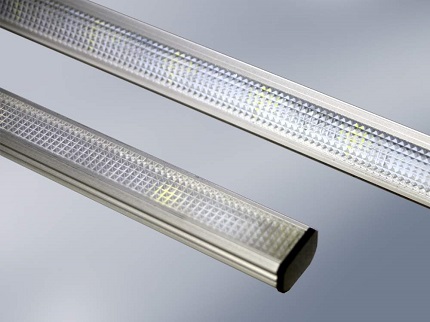
The LED lamp does not take time to ignite - this process is reproduced instantly, and the maximum level of operating brightness is immediately achieved. Subject to power outages or voltage surges, of course, the ballast of a lighting product may fail.
However, the worst option awaiting the consumer is replacing one burnt-out device, since each linear device is represented by an individual mechanism with its own electronics.
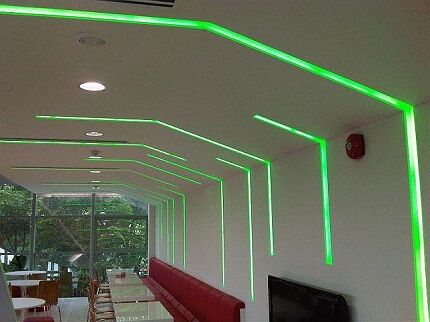
If outdated fluorescent illuminators are being modernized, then the most practical solution is changing lamps. In this case, either the old lamp body with the previous sockets can be used, or a new one can be purchased.
In the first case, you will need to select diodes that fully comply with the previous standard size. Before installation, it is necessary to remove all electromagnetic and electronic components from the circuit. ballasts or qualitatively shunt them.
Main advantages of LED
Linear LED lamps are an innovative element in industrial, commercial and public lighting systems due to insufficient awareness of the population about the main advantages of this type of lighting technology.
Key characteristics are as follows:
- Connection to a 220 V network directly without the use of ballasts and chokes.
- Low energy consumption, which allows significant savings.
- Wide dispersion angle – up to 230°.
- Depending on the manufacturer, the service life is 50,000-100,000 hours.
- The environmental friendliness of diodes does not cause harm to the environment; they are disposed of together with household waste.
- Complete absence of flicker.
- Does not heat up during prolonged use.
Also, the design features of the housing make it possible to achieve resistance to the influence of negative factors: temperature changes, moisture and stress, and mechanical stress. And due to the high color rendering coefficient and brightness level of 120 lm/W, correct visualization of surrounding objects is achieved.
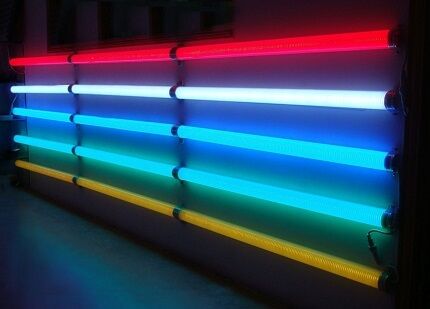
Elimination of the pulsation effect became possible thanks to the equipment with special elements - amplifier lenses and light diodes, which are responsible for compaction and concentration of the light flux.
In addition to natural monochrome cold and warm white lighting tones, manufacturers also offer various color effects (RGB design), which are mostly used for decorative purposes by entertainment venues or for illuminating advertising billboards.
The main problems accompanying the mass introduction of this technology are the high price category and the lack of government control over the quality characteristics of products presented in stores. About 50% of lighting devices do not comply with current GOST standards.
Structural design of lamps
The optional device for linear light sources is represented by a driver and soldered LEDs placed on a getinax strip. All elements are housed in an elongated flask-shaped polycarbonate body.
Using such material, manufacturers were able to eliminate the problem of mechanical damage during installation work. Since the device already has a ballast device, the tube is connected directly to the mains without ballasts.
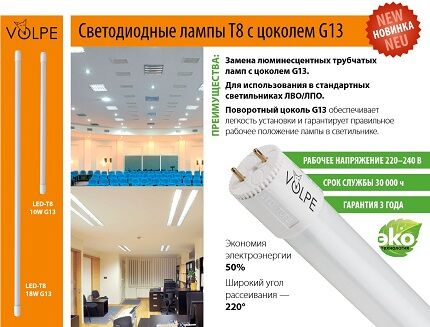
LED tubes come standard with G13 socket.There are two pins on the inside of the flask, the distance between them is 13 mm. They are connected by copper wire, so electricity can be supplied to any of them.
Length can vary from 600 mm to 1.5 m, power 9-25 W. Savings on energy bills can be up to 65%. For example, if you install an LED lamp in place of a fluorescent lamp with a power of 18 W, its nominal value will correspond to 9 W.
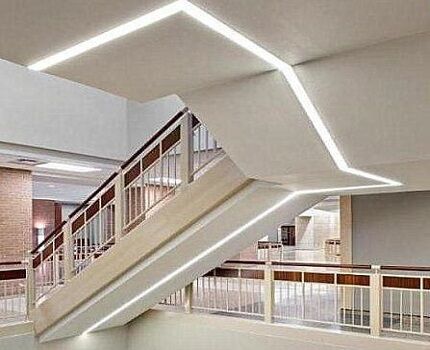
The lamp can be transparent or have a matte body. In the case where a diffuser is not provided on the lamp, it is better to opt for a matte version; if available, a transparent one will do.
Classification of LED lamps
The main purpose of linear lighting technology is to replace fluorescent lamps, which is why most tubular models are produced with a G13 base.
Location conditions
Fully equipped linear lighting devices consist of a luminaire body and one or more lamps. They can serve as the main or local lighting of various areas both indoors and in the exterior of a building or landscape design.
In addition to the main selection criteria, characteristics of a diode lamp, there are several more important criteria for the buyer.
There are various devices, according to the characteristics of which the classification is carried out:
- location;
- installation method;
- type of base;
- luminous flux intensity (lm/W);
- types of LEDs used and their quantity.
All these aspects are important in the process of selecting the right device, because...not all products have a sufficient protection factor from adverse environments or are not mobile enough for arranging the interior of a room.
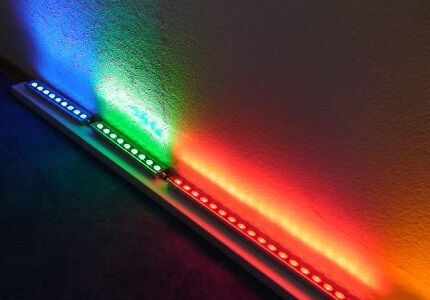
For the street, linear LED spotlights are used, which can be of various shapes and use any type of diodes: monochrome or full color. The former are capable of reproducing only one spectral range of lighting - white and its shades.
The second is any color options. Based on the climatic conditions of placement, devices are designated for different installation zones. Depending on this, the appropriate indicator of the degree of protection from an aggressive environment is selected.
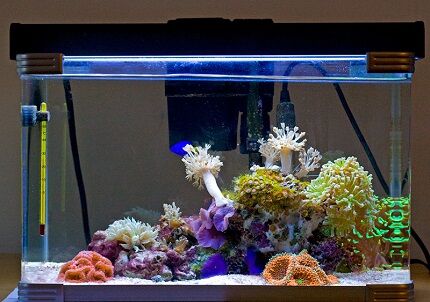
Lighting equipment marked IP65 and IP67, i.e. with the specified degree of protection, suitable for installation outdoors and in rooms with high humidity/dust formation. For example, lighting is organized in warehouses, production workshops, swimming pools, illumination of aquariums and open external areas - parking lots.
The device housing is sealed. Unique self-cleaning options also speak in their favor - due to heating during operation, ice does not form on the body and snow does not accumulate. Devices with IP20 are designed for standard settings with low humidity levels. They are used in residential or office spaces.

Linear phytolamps have a special spectrum of rays that promote the formation of chemical processes for the growth and development of plants. With their help, the continuation of daylight hours is organized for certain varieties of root crops, which has a beneficial effect on their photosynthetic activity.
Basic installation methods
Surface-mounted linear luminaires have the easiest installation system - they just need to be fixed on a flat surface. In this case, the level of inclination of the surface does not matter - the lamp has a rotating base.
Structurally, the device is designed in such a way that the user has the ability to change the lighting angle. It is due to this versatility that the models are recognized as the most popular.
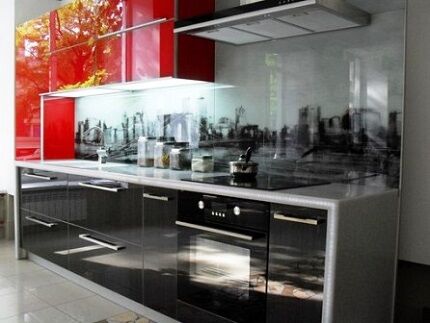
The next installation option requires preliminary preparation and organization of a niche. It is used in the construction of suspended and suspended ceilings to provide adequate lighting.
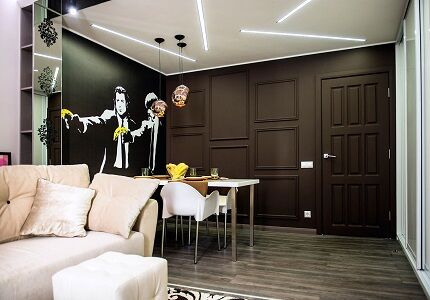
Suspended modular systems are placed at a certain distance from the ceiling using decorative chains or cables.
This mount allows you to create an entire light composition from several LED tubes, repeating the shape of various figures. To do this, they are connected to each other with special plugs.

Hanging modules also include phytolamps. If greenhouses are equipped with them, they are most often placed in a standard way - a solid line along the rows of seedlings. At home, one unit is mainly used, which is installed above the plant.
Lamp-socket connection system
In the review models of lighting equipment, two types of bases are used: G and R. However, it is worth considering that every year manufacturers expand their product line.
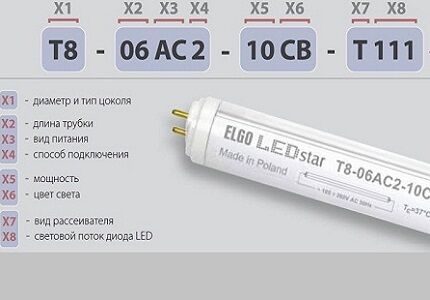
First, let's look at what the pin connection system G is. In the marking, after the letter there is a number indicating the distance between the plugs. This version of LED lamps is available in the form of an elongated bulb, as indicated by the letter T in the abbreviation. The fastening plugs here are represented by a pair of contacts of a certain length and thickness.
Tubular (T) LEDs can be of several standard sizes:
- T5 - 5/8 inch/15.9 mm;
- T8 - 8/8 inches/25.4 mm;
- T10 - 10/8 inches/31.7 mm;
- T12 - 12/8 inch/38.0 mm.
A socket with recessed contacts R is found exclusively in floodlights. According to the characteristics, the angle of light flux is insufficient to cover a large area, so it is advisable to use them for zonal illumination.
Color Temperature Options
The intensity of the light flux is selected individually.
Compliance standards are represented by the following values:
- for a power of 25 W, a light flux of 220 lm is characteristic;
- 40 W – 415 Lm;
- 60 W – 710 Lm;
- 75 W – 935 Lm;
- 100 W – 1340 Lm;
- 150 W – 2160 Lm;
- 200 W – 3040 Lm.
However, it is better to take into account the optimal indicators that do not irritate vision: warm white light - 2700 K, natural white - 4200 K. This brightness is equal to standard sun light, comfortable for the retina.
Differences between LEDs
The technical characteristics of the different types of LEDs used are presented in a wide range. Their sizes, quantity and parameters are indicated in the name of the device.

Crystals of the SMD form factor, unlike other types, are mounted on the surface of a ceramic substrate, which, in turn, is connected to the circuit board. On one substrate their number ranges from one to three.
Due to their design features, they can remove heat efficiently. As a result, the parts do not overheat even during prolonged use, which contributes to a significant increase in service life.
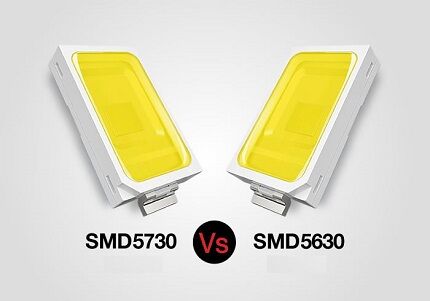
The most common options are SMD5630 and 5730. They are powerful and heavy-duty groups and are used in an electrical network with a rating of no more than 350 mA.
There are modifications mounted in the housing, with electricity consumption up to 1 A, with indicators of 1-3 W. The products have a power of up to 10 W, but their installation requires a separate cooling system.

SOV-type emitter chips are mounted directly on the board. Due to the coating with a layer of phosphor, the heat dissipation characteristics, uniformity of light projection are significantly improved and the cost of the matrix is reduced.
Features of installation of linear lamps
Linear LED lamps are installed within 5 minutes - just apply voltage to one of the plugs, and it doesn’t matter which one. It can be installed independently or together with a lamp.
Let's give an example of installing a lamp. So, on a tube of T8 or T5 format with a G13 base there are 4 contacts - 2 on both sides. There are several types of cartridges for this type of base. Their distinctive characteristics are the method of fixation to the device body, as well as the method of connecting current-carrying lines to the socket.
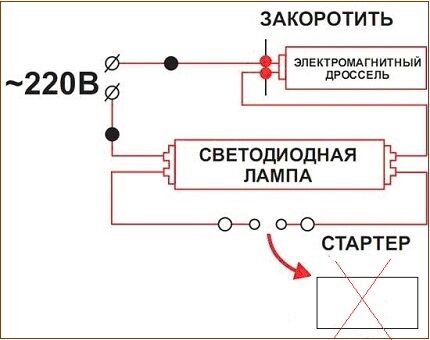
To connect a lighting device, it is necessary to apply voltage to it using the contactor included in the package. But first we open the lamp.
To do this, you will need to squeeze out the two plugs and remove them by alternately pressing a screwdriver on each of the side grooves, without applying much force so as not to break the fixing legs.Using a clamping terminal, the lamp contacts are connected to the network wires. Cover the mounting location and connecting wiring with clamps with a decorative cap.
To secure the device, the kit includes several fasteners and screws. In the desired area, we drill out the gaps for the fasteners and fix the lamp on the installed clamps. If there are several lamps, they are easily joined using adapters, also supplied in the set.
Replacing fluorescent lamps with LED lamps
The most common models of old types of fluorescent lamps are presented in two formats: 4*18 and 2*36. Both of these products are compatible with T8 bulbs and G13 socket.
Manufacturing companies produce LED lamps for various types of ballasts. First you need to determine what type of equipment is in the device.
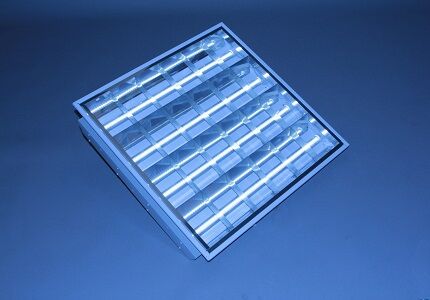
For example, to work with electronic ballasts, Philips produces a series of LEDs labeled HF. This type of lamp allows you not to change the electrical circuit of the lamp, and they are replaced like traditional fluorescent lamps.
Let's look at how to replace old lamps with LED lamps in lamps with electronic ballast.
First of all, the power to the panel is turned off. The process then looks like this:
- We remove the reflector.
- Disconnect the wires from the terminal block.
- Then we dismantle the device itself.
- We remove old lamps and starters.
- Disconnect the wires from the lamp holder using an awl and a screwdriver.
Next you need to redo the wiring. To do this, we transform the electrical circuit of the lamp - all lamp holders are connected in parallel, the wiring is inserted into the terminal block for connection to the mains voltage.
Since the second side serves as a fastener, all cables are dismantled here. A similar process is reproduced with ballasts – removal of wiring and disconnection from the circuit. We insert the base into the lamp holder with the corresponding side and the device can be installed in its original place.
If you plan to control the radiation intensity of a diode lamp, include in the line assembly circuit Dimmer. But it should be remembered that not all LED devices can work in tandem with this dimmer. Dimmable indicated in the technical data sheet of the product.
Conclusions and useful video on the topic
How to make your own LED linear lighting for the kitchen work area:
Video instructions for converting the lamp to LED bulb lamps:
Review of the linear version of lighting technology Leek Le Eco LED 36W:
When planning the installation of a new lighting device, the consumer should not forget about the wide possibilities provided by manufacturers.
Diverse series of luminaires with transparent, matte or corrugated shade designs come complete with LED lamps of different wattages and luminescence ranges, which can be selected based on your needs.
Would you like to talk about how you selected a linear diode lamp for your home or office? Do you have information that is worth sharing with potential buyers of such devices? Please write comments in the block below, ask questions and post photos on the topic of the article.




No wonder they replaced fluorescent lamps. Here you will find excellent lighting characteristics and maneuvers for all kinds of design moves. They're really superior in price, but they'll fix that soon too.
The quality of the product is rubbish, after a month the lamps began to crumble.